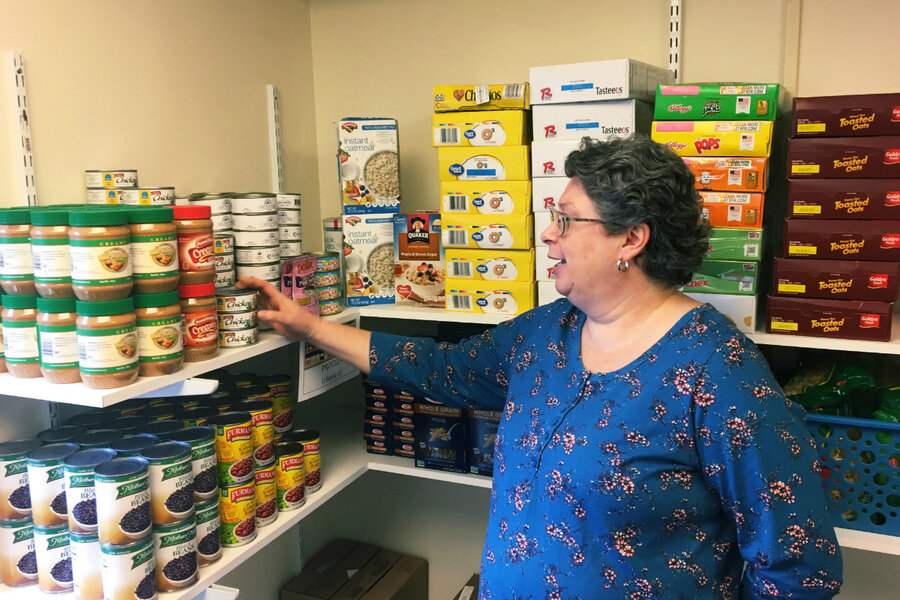On-campus food pantries help struggling students succeed in school
| Schenectady, N.Y.
Free food pantries are becoming nearly as common as the campus bookstore at a growing number of colleges.
More than 570 campus food pantries nationwide are registered with the College and University Food Bank Alliance, which formed in 2012 and helps colleges set up food pantries and other hunger programs. New York recently required that they be established at all institutions in its state university system.
"You can't concentrate when you're hungry; you're irritable, you're not focusing. I did not perform well on some exams," said Manhattan Community College student Melanie Aucello, who is working on a college degree in hopes of improving her family's quality of life.
A report published this month by a lab at the University of Wisconsin found 36 percent of 43,000 students attending two- and four-year colleges who were surveyed in 20 states had trouble getting enough to eat, threatening the academic success that's key to overcoming poverty.
Among community college students alone, 42 percent struggled to pay for balanced meals.
"We see food-insecure students devote as much time to school and homework as other students, but they also work longer hours and get less sleep," said Sara Goldrick-Rab, a Temple University sociologist and founder of the HOPE (Harvesting Opportunities for Postsecondary Education) Lab at Wisconsin.
Studies, she said, have shown such students are likely to have lower grades and graduation rates.
For young students from well-to-do families, spending time as a starving student scarfing ramen noodles is often written off as a humorous rite of passage. But the demographics of typical college students are changing, and for many, hunger is a serious reality, Dr. Goldrick-Rab said.
Food insecurity is related to soaring college costs, stagnant family incomes, a poor labor market for part-time workers, and employment requirements that make food stamps inaccessible, Goldrick-Rab said. There are also more low-income students, sometimes with children of their own, she said.
"There is no typical student who's food insecure; it can impact any type of student," said Clare Cady, a Temple University official who is co-founder of the College and University Food Bank Alliance.
Food pantries cost little to colleges because they're typically run by volunteer students and faculty and are supported by donations of food and money.
The student-run Michigan State University Student Food Bank, launched in 1993, was the first. It buys food from a regional food bank and distributes it to more than 4,000 students and their families per year.
In California, Democratic Gov. Jerry Brown in 2017 signed a law allocating $7.5 million to fight campus hunger – not only for pantries, but also for other approaches, such as helping with access to public benefits programs.
In New York, Democratic Gov. Andrew Cuomo said an initiative launched this spring makes New York the first state to require food pantries to be established at all 64 institutions in the State University of New York system. About 70 percent already had them.
At Schenectady County Community College, any student, regardless of income, can visit up to three times a month and select three days' worth of food such as canned beans, tuna, spaghetti sauce, and pasta.
"It helps immensely because it's really difficult trying to balance school and finances, and it's difficult to work to have money for groceries while in school," said biology major Hannah Daignault.
"We have a lot of students who are low-income working parents or single people struggling to get by," said Robyn King, a college counselor who coordinates the pantry. "Some receive food stamp benefits, but some make a little too much to qualify. We try to fill the gap."
Monroe Community College in Rochester seeks to provide a path to longer-term solutions. Its food wagon distributes free granola bars with labels directing students to the food pantry and Single Stop, an organization that helps students apply for government benefits such as food stamps, housing, and childcare.
"The traditional student today is older with other obligations," said Monroe president Anne Kress. "A lot of them are living in a very narrow margin between financial security and insecurity. What's going to connect them to financial security is a college degree."
This story was reported by The Associated Press.





